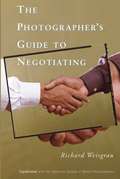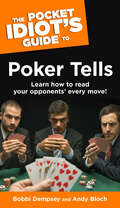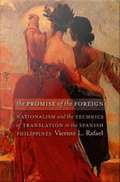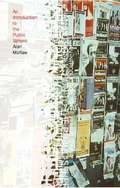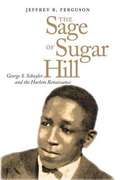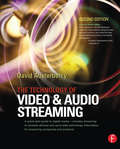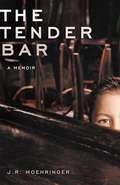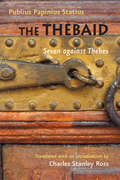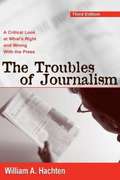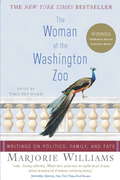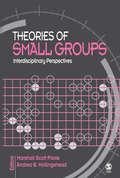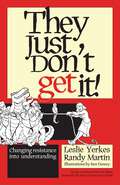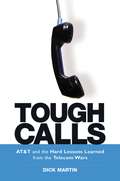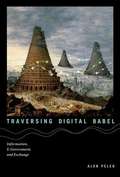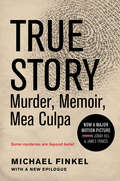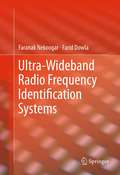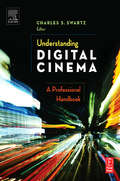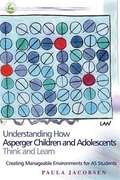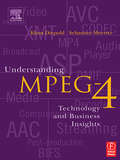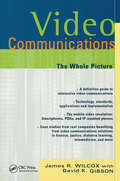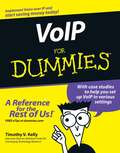- Table View
- List View
The Photographer's Guide to Negotiating
by Richard WeisgrauNegotiating is a crucial skill for anyone running a business, but they don't teach this art in photography school. The Photographer's Guide to Negotiating gives specific tips for negotiating assignment deals, digital and electronic rights, stock photography sales, contracts, purchases, and more. Interviews with an art buyer, a photographer, and a photographer's rep give photographers extra insight-and maybe even the upper hand in many negotiations. Everyone negotiates in everyday life. This book shows photographers how to take those skills and successfully apply them to business deals.Allworth Press, an imprint of Skyhorse Publishing, publishes a broad range of books on the visual and performing arts, with emphasis on the business of art. Our titles cover subjects such as graphic design, theater, branding, fine art, photography, interior design, writing, acting, film, how to start careers, business and legal forms, business practices, and more. While we don't aspire to publish a New York Times bestseller or a national bestseller, we are deeply committed to quality books that help creative professionals succeed and thrive. We often publish in areas overlooked by other publishers and welcome the author whose expertise can help our audience of readers.
The Pocket Idiot's Guide to Poker Tells: Learn How to Read Your Opponents’ Every Move!
by Bobbi Dempsey Andy BlochRead your opponent . . . and rake in the chips. The world&’s best poker players can read their opponents&’ most subtle expressions and behaviors—no matter how hard their opponents try to hide them. A tapping foot, a change in vocal tone, and countless other clues &“tell&” an informed player what cards the opponent is holding and how they&’re likely to be played. The Pocket Idiot&’s Guide® to Poker Tells explains everything amateur poker players need to start interpreting tells and using them to develop poker intuition. In this Pocket Idiot&’s Guide®, you get: • Foolproof tips to help you recognize all kinds of tells. • Game-saving advice on avoiding tells yourself—and recognizing fake ones. • Surefire strategies for dealing with the five different types of player personalities. • Idiot-proof techniques for sharpening your tell-spotting skills.
The Promise of the Foreign: Nationalism and the Technics of Translation in the Spanish Philippines
by Vicente L. RafaelIn The Promise of the Foreign, Vicente L. Rafael argues that translation was key to the emergence of Filipino nationalism in the nineteenth century. Acts of translation entailed technics from which issued the promise of nationhood. Such a promise consisted of revising the heterogeneous and violent origins of the nation by mediating one's encounter with things foreign while preserving their strangeness. Rafael examines the workings of the foreign in the Filipinos' fascination with Castilian, the language of the Spanish colonizers. In Castilian, Filipino nationalists saw the possibility of arriving at a lingua franca with which to overcome linguistic, regional, and class differences. Yet they were also keenly aware of the social limits and political hazards of this linguistic fantasy. Through close readings of nationalist newspapers and novels, the vernacular theater, and accounts of the 1896 anticolonial revolution, Rafael traces the deep ambivalence with which elite nationalists and lower-class Filipinos alike regarded Castilian. The widespread belief in the potency of Castilian meant that colonial subjects came in contact with a recurring foreignness within their own language and society. Rafael shows how they sought to tap into this uncanny power, seeing in it both the promise of nationhood and a menace to its realization. Tracing the genesis of this promise and the ramifications of its betrayal, Rafael sheds light on the paradox of nationhood arising from the possibilities and risks of translation. By repeatedly opening borders to the arrival of something other and new, translation compels the nation to host foreign presences to which it invariably finds itself held hostage. While this condition is perhaps common to other nations, Rafael shows how its unfolding in the Philippine colony would come to be claimed by Filipinos, as would the names of the dead and their ghostly emanations.
The Public Sphere: An Introduction
by Alan McKeeDrawing on many examples from contemporary media culture, Alan McKee looks at how we communicate with each other in public--and how we decide whether changing forms of communication are beneficial for the "public sphere". McKee's introduction to the concept of the public sphere, or free debate space, includes background history as well as philosophical arguments concerning its function.
The Routledge Handbook of Translation and Technology (Routledge Handbooks in Translation and Interpreting Studies)
by Minako O'HaganThe Routledge Handbook of Translation and Technology provides a comprehensive and accessible overview of the dynamically evolving relationship between translation and technology. Divided into five parts, with an editor's introduction, this volume presents the perspectives of users of translation technologies, and of researchers concerned with issues arising from the increasing interdependency between translation and technology. The chapters in this Handbook tackle the advent of technologization at both a technical and a philosophical level, based on industry practice and academic research. Containing over 30 authoritative, cutting-edge chapters, this is an essential reference and resource for those studying and researching translation and technology. The volume will also be valuable for translators, computational linguists and developers of translation tools.
The Sage of Sugar Hill: George S. Schuyler and the Harlem Renaissance
by Jeffrey B. FergusonThis book is the first to focus a bright light on the life and early career of George S. Schuyler, one of the most important intellectuals of the Harlem Renaissance. A popular journalist in black America, Schuyler wielded a sharp, double-edged wit to attack the foibles of both blacks and whites throughout the 1920s. Jeffrey B. Ferguson presents a new understanding of Schuyler as public intellectual while also offering insights into the relations between race and satire during a formative period of African-American cultural history. Ferguson discusses Schuyler's controversial career and reputation and examines the paradoxical ideas at the center of his message. The author also addresses Schuyler's drift toward the political right in his later years and how this has affected his legacy.
The Technology of Video and Audio Streaming
by David Austerberry* Learn the end-to-end process, starting with capture from a video or audio source through to the consumer's media player* A quick-start quide to streaming media technologies* How to monetize content and protect revenue with digital rights managementFor broadcasters, web developers, project managers implementing streaming media systems, David Austerberry shows how to deploy the technology on your site, from video and audio capture through to the consumer's media player. The book first deals with Internet basics and gives a thorough coverage of telecommunications networks and the last mile to the home. Video and audio formats are covered, as well as compression standards including Windows Media and MPEG-4. The book then guides you through the streaming process, showing in-depth how to encode audio and video. The deployment of media servers, live webcasting and how the stream is displayed by the consumer's media player are also covered.A final section on associated technologies illustrates how you can protect your revenue sources with digital rights management, looks at content delivery networks and provides examples of successful streaming applications.The supporting website, www.davidausterberry.com/streaming.html, offers updated links to sources of information, manufacturers and suppliers.David Austerberry is co-owner of the new media communications consultancy, Informed Sauce. He has worked with streaming media since the late nineties. Before that, he has been product manager for a number of broadcast equipment manufacturers, and formerly had many years with a leading broadcaster.
The Tender Bar: A Memoir
by J. R. MoehringerAutobiography of a news reporter abandoned by his father, a New York City disc jockey who vanished before J. R. spoke his first word.
The Thebaid: Seven against Thebes (Johns Hopkins New Translations from Antiquity)
by Publius Papinius StatiusA classical epic of fratricide and war, the Thebaid retells the legendary conflict between the sons of Oedipus—Polynices and Eteocles—for control of the city of Thebes. The Latin poet Statius reworks a familiar story from Greek myth, dramatized long before by Aeschylus in his tragedy Seven against Thebes. Statius chose his subject well: the Rome of his day, ruled by the emperor Domitian, was not too distant from the civil wars that had threatened the survival of the empire. Published in 92 A.D., the Thebaid was an immediate success, and its fame grew in succeeding centuries. It reached its peak of popularity in the later Middle Ages and Renaissance, influencing Dante, Chaucer, and perhaps Shakespeare. In recent times, however, it has received perhaps less attention than it deserves, in large part because there has been no accessible, dynamic translation of the work into English.Charles Stanley Ross offers a compelling version of the Thebaid rendered into forceful, modern English. Casting Statius's Latin hexameter into a lively iambic pentameter more natural to the modern ear, Ross frees the work from the archaic formality that has marred previous translations. His translation reinvigorates the Thebaid as a whole: its meditative first half and its violent second half; its intimate portrayal of defeat and retribution, and the need to seek justice at any cost. In a wide-ranging introduction, Ross provides an overview of the poem: its composition, reception and legacy; its major themes and literary influences; and its place in Statius' life. And in a helpful series of notes, he offers background information on the major characters and incidents.
The Troubles of Journalism
by William A. HachtenTaking stock of the current news environment, author William A. Hachten provides this thorough update to his insider's examination of the U.S. journalism profession. He considers the critiques of journalism and evaluates the changes taking place that have resulted in both positive and negative outcomes.
The Woman at the Washington Zoo: Writings on Politics, Family, and Fate
by Marjorie WilliamsOne of Washington's finest writers on people, politics, and life ? collected for the first time.
Theories of Small Groups: Interdisciplinary Perspectives
by Marshall Scott Poole Andrea B. HollingsheadTheories of Small Groups: Interdisciplinary Perspectives brings together the threads that unify the field of group research. The book is designed to define and describe theoretical perspectives on groups and to highlight select research findings within those perspectives. In this text, editors Marshall Scott Poole and Andrea B. Hollingshead capitalize on the theoretical advances made over the last fifty years by integrating models and theories of small groups into a set of nine general theoretical perspectives. Theories of Small Groups is the first book to assess, synthesize, integrate, and evaluate the body of theory and research on small groups across disciplinary boundaries.
They Just Don't Get It!: Changing Resistance Into Understanding
by Leslie Yerkes Randy MartinThey Just Don't Get It! explores an all-too-common dilemma: when people around us just don't "get" our ideas. Through a charming illustrated fable, it tells the story of Julie Buffet, a hard-charging advertising executive with what she thinks is a fantastic idea for a new campaign. But nobody gets it-not the client, not her boss, and not her coworkers. And Julie can't understand why.We have all found ourselves in this situation at one time or another, and we typically see this problem as a failing on the part of the other party. They Just Don't Get It! shows that when they don't get it, the problem is really with ourselves. And it shows how we can finally really get it.If you've ever wondered why your ideas haven't been received or acted on in the way you expected, this book will reveal your own personal responsibility in helping others understand your intentions. Examining the root source of the problem, it details five keys to "getting it"-Take Responsibility; Practice Humility; Begin with Questions; Remain Open; and Believe They Can. These five simple steps will enable you to overcome the problem, and prevent it from happening in the future.They Just Don't Get It! will teach you how to communicate your ideas better, and how to motivate others to pull together and achieve your highest goals in any situation.
Tough Calls: ATand T and the Hard Lessons Learned from the Telecom Wars
by Dick MartinFor better and for worse, few companies have been so prominently and constantly in the public eye as AT&T. Through decades of growth and dominance, followed by its 1984 breakup and a litany of well-documented troubles, the company has soldiered on, by turns thriving and hanging on for dear life.Perhaps no individual experienced as much of the roller-coaster ride as Dick Martin, an executive vice president and 30-year AT&T veteran with both a bird’s-eye view of and a crucial role in the company’s bumpy history.Tough Calls is the ultimate inside look at how AT&T tried to cope with a “perfect storm” of fierce competition, economic turmoil, and punishing media scrutiny. <P><P>Mixing unflinching candor with love for the company he helped steer -- and clear respect for many of his long-time colleagues -- Martin takes you through boardroom and back room to shed unprecedented light on:* How the 1996 bungled announcement of 40,000 layoffs nearly destroyed the company* How flawed succession planning precipitated sharp declines in AT&T’s stock price* The never-ending, ugly turf battles with the “Baby Bells” brought on by the AT&T breakup* How even small interest groups can have a tremendous influence on business decisions, and how the media are largely responsible for determining what is business news on any given day Tough Calls is also a cautionary tale to be heeded by all businesses, using AT&T’s experience in the brutal telecom wars as a backdrop for new strategies in weathering unforgiving business conditions. <P>Just a few of the lessons to be learned include:* How to avoid the most common mistakes that executives make, such as being held hostage by unrealistic expectations, waiting too long to make critical changes, and building their celebrity rather than their credibility* How to balance internal and external communications, and how and when to deal with the business media* How to improve relationships between PR executives and the “C” suite -- CEO, CFO, Chief Counsel, etc.--and how to make public relations more strategic* How to build and sustain favorable brand recognition and investor allure even in the face of bitter competition and unpredictable market conditionsAs candid and fascinating as it is constructive, Tough Calls is itself a call to attention and to arms, in preparation for the many battles that every business must eventually face, against fierce adversaries, and even within its own camp.
Traversing Digital Babel
by Alon PeledThe computer systems of government agencies are notoriously complex. New technologies are piled on older technologies, creating layers that call to mind an archaeological dig. Obsolete programming languages and closed mainframe designs offer barriers to integration with other agency systems. Worldwide, these unwieldy systems waste billions of dollars, keep citizens from receiving services, and even -- as seen in interoperability failures on 9/11 and during Hurricane Katrina -- cost lives. In this book, Alon Peled offers a groundbreaking approach for enabling information sharing among public sector agencies: using selective incentives to "nudge" agencies to exchange information assets. Peled proposes the establishment of a Public Sector Information Exchange (PSIE), through which agencies would trade information. After describing public sector information sharing failures and the advantages of incentivized sharing, Peled examines the U.S. Open Data program, and the gap between its rhetoric and results. He offers examples of creative public sector information sharing in the United States, Australia, Brazil, the Netherlands, and Iceland. Peled argues that information is a contested commodity, and draws lessons from the trade histories of other contested commodities -- including cadavers for anatomical dissection in nineteenth-century Britain. He explains how agencies can exchange information as a contested commodity through a PSIE program tailored to an individual country's needs, and he describes the legal, economic, and technical foundations of such a program. Touching on issues from data ownership to freedom of information, Peled offers pragmatic advice to politicians, bureaucrats, technologists, and citizens for revitalizing critical information flows.
True Story: Murder, Memoir, Mea Culpa
by Michael FinkelIn the haunting tradition of Joe McGinniss's Fatal Vision and Mikal Gilmore's Shot in the Heart, True Story: Murder, Memoir, Mea Culpa weaves a spellbinding tale of murder, love, and deceit with a deeply personal inquiry into the slippery nature of truth. The story begins in February of 2002, when a reporter in Oregon contacts New York Times Magazine writer Michael Finkel with a startling piece of news. A young, highly intelligent man named Christian Longo, on the FBI's Ten Most Wanted list for killing his entire family, has recently been captured in Mexico, where he'd taken on a new identity-Michael Finkel of the New York Times. The next day, on page A-3 of the Times, comes another bit of troubling news: a note, written by the paper's editors, explaining that Finkel has falsified parts of an investigative article and has been fired. This unlikely confluence sets the stage for a bizarre and intense relationship. After Longo's arrest, the only journalist the accused murderer will speak with is the real Michael Finkel. And as the months until Longo's trial tick away, the two men talk for dozens of hours on the telephone, meet in the jailhouse visiting room, and exchange nearly a thousand pages of handwritten letters. With Longo insisting he can prove his innocence, Finkel strives to uncover what really happened to Longo's family, and his quest becomes less a reporting job than a psychological cat-and-mouse game-sometimes redemptively honest, other times slyly manipulative. Finkel's pursuit pays off only at the end, when Longo, after a lifetime of deception, finally says what he wouldn't even admit in court-the whole, true story. Or so it seems.
True Story: Murder, Memoir, Mea Culpa
by Michael FinkelIn the haunting tradition of Joe McGinniss's Fatal Vision and Mikal Gilmore's Shot in the Heart, True Story: Murder, Memoir, Mea Culpa weaves a spellbinding tale of murder, love, and deceit with a deeply personal inquiry into the slippery nature of truth.The story begins in February of 2002, when a reporter in Oregon contacts New York Times Magazine writer Michael Finkel with a startling piece of news. A young, highly intelligent man named Christian Longo, on the FBI's Ten Most Wanted list for killing his entire family, has recently been captured in Mexico, where he'd taken on a new identity--Michael Finkel of the New York Times.The next day, on page A-3 of the Times, comes another bit of troubling news: a note, written by the paper's editors, explaining that Finkel has falsified parts of an investigative article and has been fired. This unlikely confluence sets the stage for a bizarre and intense relationship. After Longo's arrest, the only journalist the accused murderer will speak with is the real Michael Finkel. And as the months until Longo's trial tick away, the two men talk for dozens of hours on the telephone, meet in the jailhouse visiting room, and exchange nearly a thousand pages of handwritten letters.With Longo insisting he can prove his innocence, Finkel strives to uncover what really happened to Longo's family, and his quest becomes less a reporting job than a psychological cat-and-mouse game--sometimes redemptively honest, other times slyly manipulative. Finkel's pursuit pays off only at the end, when Longo, after a lifetime of deception, finally says what he wouldn't even admit in court--the whole, true story. Or so it seems.
True Story: Murder, Memoir, Mea Culpa
by Michael FinkelIn the haunting tradition of Joe McGinniss's Fatal Vision and Mikal Gilmore's Shot in the Heart, True Story: Murder, Memoir, Mea Culpa weaves a spellbinding tale of murder, love, and deceit with a deeply personal inquiry into the slippery nature of truth.The story begins in February of 2002, when a reporter in Oregon contacts New York Times Magazine writer Michael Finkel with a startling piece of news. A young, highly intelligent man named Christian Longo, on the FBI's Ten Most Wanted list for killing his entire family, has recently been captured in Mexico, where he'd taken on a new identity--Michael Finkel of the New York Times.The next day, on page A-3 of the Times, comes another bit of troubling news: a note, written by the paper's editors, explaining that Finkel has falsified parts of an investigative article and has been fired. This unlikely confluence sets the stage for a bizarre and intense relationship. After Longo's arrest, the only journalist the accused murderer will speak with is the real Michael Finkel. And as the months until Longo's trial tick away, the two men talk for dozens of hours on the telephone, meet in the jailhouse visiting room, and exchange nearly a thousand pages of handwritten letters.With Longo insisting he can prove his innocence, Finkel strives to uncover what really happened to Longo's family, and his quest becomes less a reporting job than a psychological cat-and-mouse game--sometimes redemptively honest, other times slyly manipulative. Finkel's pursuit pays off only at the end, when Longo, after a lifetime of deception, finally says what he wouldn't even admit in court--the whole, true story. Or so it seems.
Ultra-Wideband Radio Frequency Identification Systems
by Farid Dowla Faranak NekoogarUltra-wideband Radio Frequency Identification Systems describes the essentials of radio frequency identification (RFID)systems as well as their target markets. The book covers a study of commercially available RFID systems and characterizes their performance in terms of read range and reliability in the presence of conductive and dielectric materials. The capabilities and limitations of commercial RFID systems are reported followed by comprehensive discussions of the advantages and challenges of using ultra-wideband (UWB) technology for tag/reader communications. The book presents practical aspects of RFID system such as: EPC global and ISO standards, implementation, and target markets in a simple and easy to understand language.
Understanding Digital Cinema: A Professional Handbook
by Charles S. SwartzUNDERSTANDING DIGITAL CINEMA: A PROFESSIONAL HANDBOOK is a comprehensive resource on all aspects of finishing, distributing and displaying film digitally. For technical professionals as well as non-technical decision-makers, the book is a detailed exploration of every component of the process, from mastering to theater management. * An overview of digital cinema system requirements* Post production work flow* Color in digital cinema* The digital cinema mastering process* Fundamentals of compression * Security* Basics of audio * Digital distribution* Digital projection technology* Theater systems* The international perspective: Views from Europe, Asia and Latin America* A realistic assessment of the future of digital cinemaWith contributions by:Richard Crudo, President, American Society of CinematographersLeon Silverman, Executive Vice President, Laser Pacific Media CorporationCharles Poynton, Color ScientistChris Carey, Senior Vice President, Studio New Technology, The Walt Disney StudiosBob Lambert, Corporate Senior Vice President New Technology & New Media,The Walt Disney CompanyBill Kinder, Pixar Animation StudiosGlenn Kennel, DLP CinemaPeter Symes, Manager, Advanced Technology, Thomson Broadcast & Media SolutionsRobert Schumann, President, Cinea, Inc., A Subsidiary of Dolby LabsDavid Gray, Vice President, Production Services, Dolby Laboratories, Inc.Darcy Antonellis, Executive Vice President, Distribution and Technology OperationsWarner Bros. Technical Operations Inc. and Senior Vice President, Worldwide Anti-Piracy Operations Warner Bros. Entertainment Inc.Matt Cowan, Principal and Founder, Entertainment Technology ConsultantsLoren Nielsen, Principal and Founder, Entertainment Technology ConsultantsMichael Karagosian, Partner, Karagosian MacCalla Partners (KMP)Peter Wilson, Vice President, Display Technologies, Snell and Wilcox Ltd.Patrick Von Sychowski, Senior Analyst, Screen DigestWendy Aylsworth, Vice President of Technology, Warner Bros. Technical Operations Inc.
Understanding How Asperger Children and Adolescents Think and Learn: Creating Manageable Environments for AS Students
by Paula JacobsenUnderstanding How Asperger Children and Adolescents Think and Learn helps educators appreciate the learning process and improve its effectiveness for students with Asperger Syndrome. The author provides a compelling inside view of how AS pupils perceive and understand what goes on in the classroom, and how they, in turn, are perceived by fellow pupils and teachers. She adopts a pragmatic approach to improving communications in the classroom and offers practical intervention strategies to increase mutual understanding and create a rewarding and supportive learning environment. The book also includes many examples of behavior commonly observed in AS children, and illuminating accounts of specific children's experiences, which help to understand the learning process and avoid misunderstandings. This accessible book is a key resource for educators and parents of AS children and provides invaluable guidance and strategies for professionals who need to understand how AS pupils learn and communicate.
Understanding MPEG 4: Technology and Business Insights
by Sebastian Moeritz Klaus DiepoldThe Practical Guide to MPEG 4 offers an up to date introduction to this important interactive and multimedia compression standard (including MPEG-4 Part 10), with real examples and information as to how and where this new technology should be used. All aspects of MPEG-4 that are relevant in today's technical landscape are described in this book, including video and audio creation, production, distribution, reception and consumption environment. This book explains everything you really need to know in jargon-free language: interactive systems, content management, deployment, licensing and business models.
Video Communications: The Whole Picture
by David Gibson James WilcoxCase studies document how, in businesses all across this country, people are communicating via videoconferences with broadcast quality reception. The authors detail how the proliferation of IP networks has driven quality improvements and cost savings in
VoIP For Dummies
by Timothy V. KellyPut your phone system on your computer network and see the savingsSee how to get started with VoIP, how it works, and why it saves you moneyVoIP is techspeak for "voice over Internet protocol," but it could spell "saving big bucks" for your business! Here's where to get the scoop in plain English. Find out how VoIP can save you money, how voice communication travels online, and how to choose the best way to integrate your phone system with your network at home or at the office.Discover how to:Use VoIP for your business or home phone serviceChoose the best network typeSet up VoIP on a wireless networkUnderstand transports and servicesDemonstrate VoIP's advantages to management
WCDMA Design Handbook
by Andrew RichardsonDeveloped out of a successful professional engineering course, this practical handbook was originally published in 2005, and provides a comprehensive explanation of the Wideband CDMA (Code Division Multiple Access) air interface of 3rd generation UMTS cellular systems. The book addresses all aspects of the design of the WCDMA radio interface from the lower layers to the upper layers of the protocol architecture. It considers each of the layers in turn, to build a complete understanding of the design and operation of the WCDMA radio interface including the physical layer, RF and baseband processing, MAC, RLC, PDCP/BMP, Non-Access stratum and RRC. An ideal course book and reference for professional engineers, undergraduate and graduate students.
